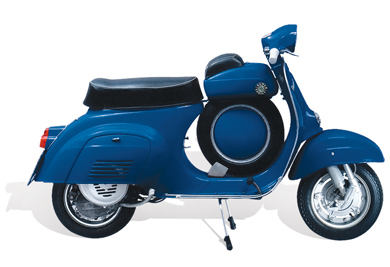Postage free from 99€ (DE)
High customer satisfaction

In 1965, the Vespa Super Sprint was released. The name says it all—not only does it have an extremely sporty appearance, but it also features an improved version of the Vespa V50/90 engine. The Vespa Super Sprint won the first Italy endurance race and several other competitions.
A new addition is the four-speed transmission. The engine breathes through a 16/16 Dell’Orto carburetor. A significant part of the increased performance is due to the exhaust system developed specifically for this model. According to Vespa Tecnica Vol. 3: “The chrome-plated steel exhaust produces a metallic and typically sporty sound and gives the vehicle a more dynamic look.”
Alongside the exhaust, many other parts are unique to the Super Sprint—but luckily, they can also be fitted to other Smallframe models. The handlebar, with a white speedometer up to 100 km/h, is perhaps the ancestor of all dropbars. It’s much narrower and slightly angled.
The Super Sprint seat opens to the rear, not the front. It is smaller and narrower overall, emphasizing the bike’s sporty silhouette. Another distinctive feature is the tank located between the leg shield and seat, which is actually a luggage compartment. Reproductions—initially made from fiberglass—appeared over 10 years ago. The small cushion on top is both a visual highlight and a comfort feature for lying flat in an aerodynamic riding position to reach 85 km/h. Each side of the luggage box bears a “90 Super Sprint” sticker. Underneath this dummy tank sits a spare wheel, positioned transversely like on record-breaking bikes of the past.
To create a more compact look, two color-matched hubcaps are mounted. On early versions, the spare wheel is fixed with a claw in the center of the floorboard. The front fender is more streamlined, contributing to the racy appearance even when stationary. The entire leg shield is narrower and tapers upward, achieving better aerodynamic values. The floorboard is also narrower and equipped with a smaller center stand.
The Super Sprint is among the most iconic Vespas and has enjoyed enormous popularity for decades. This demand has led to sky-high prices, making it one of the most expensive Vespa models from the 1960s. Ironically, it was also one of Piaggio’s biggest flops. Only around 5,300 SS 90 units were made for the Italian market, plus approximately 2,500 SS 50s for export.
Its low production numbers and many unique parts make the Super Sprint highly collectible. Many bikes were used for racing due to their excellent handling, and thus few remain in pristine condition.
High demand led to reproductions over the years. A decade ago, most came from England in fiberglass—today, many are sheet metal reproductions from Asia. With good parts availability, building a replica of this coveted sports model is now relatively easy. We teamed up with Blechwerk to convert a wrecked 50cc bike to test the parts' quality and highlight any potential issues during the build.












